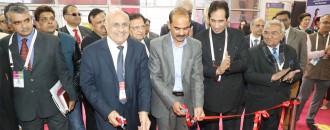
Another promising year awaits India’s textiles exports
Satyapal Menon | The Dollar Business
 A craftsman uses a handloom to produce rugs in Jodhpur, India
A craftsman uses a handloom to produce rugs in Jodhpur, IndiaIndian history and tradition is woven around the sheer artistry, and pure genius that goes into the creation of intricate and intrinsic cloth patterns conceived by thousands of weavers across the length and breadth of the country. From the mesmerising valleys of Kashmir to the serene shores of Kanyakumari, and, from the dusty and dry habitats on the Deserts of Rajasthan to the freezing terrain of the Himalayan region, India is linked, and, interlinked by a common thread of omnipresent tradition. Many villages and towns across the country reverberate with the pervasive rhythm of looms weaving out exquisite ensemble of textiles. The textile industry is one of the largest contributing sectors of India’s exports contributing nearly 13.25% of the country’s total exports basket with exports to the tune of $41.57 billion (about Rs. 2,65,100 crore) in FY2013-14. This year, India jumped up two places over Germany and Italy to occupy the podium at number two position, next to China, in textile exports. The textile industry has two broad segments, namely handloom, handicrafts, sericulture, powerlooms in the unorganised sector and spinning, apparel, garmenting, made-ups in the organised sector. However, despite contributing to a considerable chunk of the exports from India, the textile segment is yet to be tapped to its total inherent potential, particularly in the handloom sector. There have been no dearth of initiatives from the part of the governments over the years to give impetus to the growth of this sector by setting up Integrated Textile Parks (ITPs) in various sub-segments of the industry. The last year had witnessed a slackening of this activity, but the process was revived with the Centre coming out with a slew of schemes and incentives to further invigorate the industry. Apart from the Rs.520 crore allocated for setting up of 13 new Integrated Textile Parks (ITPs), the government has decided to extend duty free entitlement to garment exporters for import of trimmings, embellishments and other specified items increased from 3% to 5%. According to Santosh Kumar Gangwar, Textiles Minister, “This initiative is expected to generate an additional RMG exports estimated at Rs.10,000 Crore.” Ready Made Garments (RMG) contributes to a lion’s share of global trade with a chunk of 55% in the total exports. India is ranked sixth with exports to the tune of $16 billion, which is around 40% of the country's textiles exports. Another significant decision taken by the government this year was the dropping of the proposal for imposing duty on branded items thus providing relief to the entire value chain. The government has decided to extend 24/7 customs clearance facility at 13 airports and 14 sea ports resulting in faster clearance of import and export cargo. According to the Textiles Ministry, the plan to set up the new ITP’s is estimated to bring in private sector investment of about Rs.3,240 crores into the sector and generate direct employment for about 35,000 persons over the next three years. In addition, a fresh advertisement would be issued calling for proposals for more ITPs for utilisation of the balance provision during the 12th plan period. Proposals are also on the anvil to synergise handloom, handicraft with tourism has been worked out in consultation with Ministry of Tourism, said the Textiles Ministry. The plan envisages traditional handloom weavers/handicraft artisans’ villages for development as “Adarsh Gram” as tourists destinations. In addition to this, setting up of Trade Facilitation Centre and Craft Museum in India’s silk hub, Varanasi, to facilitate weavers, artisans and entrepreneurs to boost their marketing activities in domestic as well as international markets. According to the Confederation of Indian Textile Industry, India contributes about 11% to industrial production, 17% to the manufacturing sector, and, 2% to the GDP, and is the second largest employment provider after agriculture. The fundamental strength of this industry flows from its strong production base of wide range of fibres/yarns from natural fibres like cotton, jute, silk and wool to synthetic/man-made fibres like polyester, viscose, nylon and acrylic. India has the potential to increase its textile and apparel share in the world trade from the current level of 4.5% to 8% and reach $80 billion (about Rs.5,10,000 crore) by 2020. The report of the Working Group constituted by the Planning Commission on boosting India’s manufacturing exports during 12th Five Year Plan (2012-17), envisages India’s exports of textiles and clothing at Rs.3,86,814 crores by the end of March, 2017. In the global exports market of clothing, India is ranked the fifth largest exporter, trailing Bangladesh, Hong Kong, EU and China. India is also expected to consolidate its position in the coming years. According to the Ministry of Textiles, the domestic textile and apparel industry in India is estimated to reach $141 billion (about Rs.9,00,000 crore) by 2021 from $58 billion (about Rs.3,67,000 crore) in 2011. Apparel exports from India is expected to increase to $82 billion (about Rs.5,23,000 crore) by 2021 from $31 billion (about Rs.2,00,000 crore) in 2011. Total cloth production in India is expected to grow to 112 billion square meters by FY17 from 62 billion square meters in FY11. Here are some more amazing textures of India’s Textile Industry. India is the second largest exporter of textiles, next only to China. India is second largest cotton and cellulosic fibers producing country in the world, second largest producer of silk and contributes about 18% to the total world raw silk production, the largest producer and second largest exporter of the jute goods. India also has the 3rd largest sheep population in the world, having 6.15 crores sheep, producing 45 million kg of raw wool, and accounting for 3.1% of total world wool production. India ranks 6th among clean wool producer countries and 9th amongst greasy wool producers and ranks fourth in the world in the synthetic fibres/yarn segment. The textile sector can look into the future with increasing optimism, going by the forecast presented by USDA and International Cotton Advisory Committee (ICAC). World consumption is forecast to rise by 2%, to just under 24,000,000 tonnes, with an anticipation that 2014-15 will be the fifth consecutive season to show a rise in world stocks.
This article was published on December 27, 2014.






 to success.
to success.